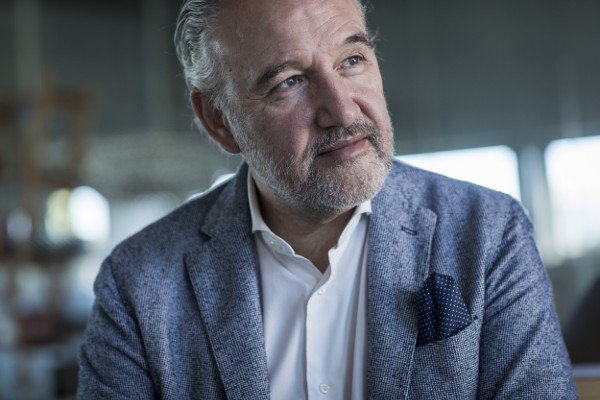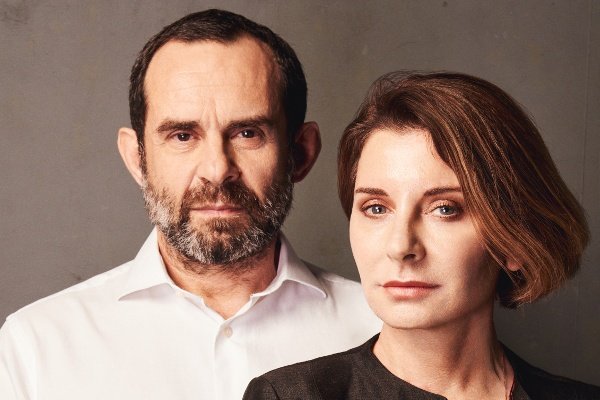LUCE 338 | PREVIEW
In this issue:

THE MASTERS
ERNESTO GISMONDI, A WORD OF LIGHT
by Monica Moro
Artemis, the Greek goddess of the moon who guides our steps in the night, but also the destination, in the 1960s, of the ultimate space exploration that led to the moon landing: this is the name chosen for an Italian company that truly brought light and Italian lamps to the world. First founded by Ernesto Gismondi with Sergio Mazza, it was then shared with Carlotta de Bevilacqua, who now heads the group. Ernesto Gismondi was a man of light: light declined in the distinctive way of innovation at the service of humanity and in the quest for beauty. His voice was the first to be heard at the traditional Salone del Mobile in Milan, and his vision was eagerly awaited by journalists, but also by the whole international design industry. Originally from Liguria, he was born in Sanremo on Christmas Day and left us on December 31, 2020, the start of a historic year. And, indeed, his life path was as bright as the wake of a comet.
LUCE remembers him with great esteem and affection one year after his death.

ASSOCIATIONS
IALD: THE INTERNATIONAL LIGHTING DESIGN
INTERVIEWING MÔNICA LUZ LOBO AND ASHLEY ROBBINS
by Carlo D’Alesio
Aiming to set the global standard for excellence in lighting design, IALD is the authority on lighting design for the international community. In addition to promoting and supporting the profession, the association provides education and service to its members, currently a network of more than 1,500 independent lighting designers. Professional members are accepted through a rigorous qualification process. IALD’s mission is to “advance the global lighting design profession through leadership and advocacy and to provide service to members by promoting education, community and engagement”. LUCE is pleased to present this choral interview with two key figures of the IALD, to whom we are grateful for their time and dedication: Mônica Luz Lobo, IALD President Elect, and Ashley Robbins, IALD Interim CEO.

ASSOCIATIONS
“THE NUMBER ONE PROBLEM? THE PROLIFERATION OF REGULATION”
INTERVIEW WITH CARLO URBINATI OF ASSOLUCE
by Pietro Mezzi
Born in Genoa in 1955, Carlo Urbinati has been at the helm of Assoluce since last July. A trade association that is part of FederlegnoArredo, Assoluce is made up of leading Italian lighting manufacturers. He is at the head of a sector that has been increasing its sales since the early months of this year, after the difficulties of 2020, and that has always exported to all international markets. For Assoluce, the production of European laws and standards threatens to bring to its knees an important part of the lighting technology sector, which is made up of small and medium-sized enterprises that have based their fortunes, as well as those of the Made in Italy, on quality and creativity: “This is why we need to be in Brussels.”

ARCHITECTS
LIGHT IS A TRANSPARENT DRESS BOUND TO ILLUMINATE WHAT WE WOULD NOT SEEE OTHERWISE
THE MEETING WITH LUDOVICA SERAFINI
by Monica Moro
We had the pleasure of interviewing for LUCE architect Ludovica Serafini, from PS+A Palomba Serafini Associati. Based in Milan, the studio was founded in 1994 by Ludovica Serafini and Roberto Palomba, both graduates in architecture from Rome’s Sapienza University. Their vision is a dual vision guided by a unique intuition that merges into a “human centric” design philosophy, where the focus is on the human being. They share the ability to combine a contemporary vision of society with the historical and cultural needs of people, architecture and design. They have received many prizes and awards, including: Compasso d’Oro 2011, Elle Deco International Design Award, Good Design Award, German Design Award.

CORRESPONDENCES
LIVING IN THE DARK: A FRIDAY EVENING THAT LASTS THREE MONTHS
by Matilde Alessandra
Located halfway between the North Pole and the northern coast of Norway, the Svalbard archipelago in the High Arctic is a legendary paradise of majestic glaciers and polar bears. Discovered at the end of the 16th century, they have been home to whalers, trappers and, in the 20th century, American, Russian, and Swedish mining companies. The “capital” Longyearbyen is the northernmost town in the world: this community, isolated from everything and everyone, has about 2,000 inhabitants and a life rich in culture and events, with two museums, a library, a cinema, schools, and a small hospital. But the most striking feature of this place is the light, as there are essentially only two seasons: a long summer of continuous light – the well-known midnight sun – and a winter in which the sun disappears for a few months, starting officially on 26 October. But how does one live in the dark?

INTERVIEWS
“MUSEUMS OFFER UNDERSTANDING, NOT KNOWLEDGE”: THE MEETING WITH FIORENZO GALLI, DIRECTOR OF THE SCIENCE AND TECHNOLOGY MUSEUM IN MILAN
by Marcello Filibeck
The National Museum of Science and Technology in Milan is one of the most prestigious cultural institutions in Italy. Opened in 1953, it is named after Leonardo Da Vinci, who was a scientist, inventor and artist. He is indeed the best representative of the Museum of Science’s vision, based on the continuity between the artistic culture and the scientific-technological one. This vision is spread through the museum’s collection and activities, promoting an interdisciplinary approach to knowledge. We met Fiorenzo Galli, General Director since 2001, who gave us his point of view on the role and mission of the Science Museum and of all cultural institutions.

LIGHT ART
FABRIZIO PLESSI’S VITA NOVA
by Jacqueline Ceresoli
Born in Reggio Emilia in 1940, Plessi lives and works in Venice and is considered a pioneer of video art in Italy. After 540 solo exhibitions, works displayed in 138 museums and countless drawings and sketches, at the age of eighty he continues to reflect on the need to humanise technology, particularly in Abu Dhabi with the exhibition entitled Plessi’s Digital Wall hosted in the new Italian Cultural Institute. The tireless “alchemist” plays with techniques and languages, searching for forms that underlie the fundamental elements of aesthetic perception, in which light as a symbol of spatiality becomes an aesthetic subject and the experience of a spiritual digital, a parameter for reflection as well as an object-subject of visual and conceptual experience.
In LUCE 338.2021 you will find many other articles, special reports, interviews, and insights. We are always on the lookout for new suggestions and ideas to understand, explain and raise awareness of the world of Italian and international lighting. Keep reading and writing to us.
TALES OF LIGHT
THE OUTPOST
by Isidora Tesic
EDUCATION
PAOLA ALBINI TALKS ABOUT THE FRANCO ALBINI ACADEMY
by Andrea Calatroni
CIE ITALY
CIE 2021: A UNIQUE EVENT IN THE HISTORY OF THE CIE
by Laura Bellia
LIGHT AND LANDSCAPE SPECIAL REPORT
THE EVOLUTION OF THE ILLUMINATED LANDSCAPE: THE POINT OF VIEW OF ALBERTO RIVA
by Laura Bellia and Andrea Calatroni
DESIGNING LIGHT
THE NEW ARCHIVE OF BITOSSI CERAMICS
by Monica Moro
MAXXI L’AQUILA
by Massimo Gozzi
DIAPHRAGMS OF LIGHT: THE LOUVRE IN ABU DHABI
by Alessandra Reggiani
LIGHTING DESIGNERS
LEVEL AFTER LEVEL, TOWARDS A CULTURE OF LIGHT. INTERVIEW WITH LISA MARCHESI
by Federica Capoduri
LIGHT BETWEEN SYMPHONY AND TAILORING. INTERVIEW WITH MARCO STIGNANI
by Federica Capoduri
DESIGNERS
“WHAT DOES LIGHT MEAN TO YOU?“THE ANSWER FROM CARLO FORCOLINI, WINNER OF THE COMPASSO D’ORO CAREER AWARD 2020
by Pierluigi Masini
LIGHT AND MUSEUM SPACES: PROJECTS BY LAURA MIOTTO
by Pietro Mezzi
LIGHT ART
FEDERICA MARANGONI. THE TRASPARENT OBJECT
by Jacqueline Ceresoli
RESEARCH
AN INTRODUCTION TO THE EVOLUTION OF THE RESIDENTIAL LIGHTING DESIGN
by Maurizio Rossi
MAKING OF
NEBULA: REWRITING THE RULES OF LIGHT
by Andrea Calatroni
AGRITECH: THE LIGHT THAT MAKES PLANT GROW
by Andrea Calatroni

